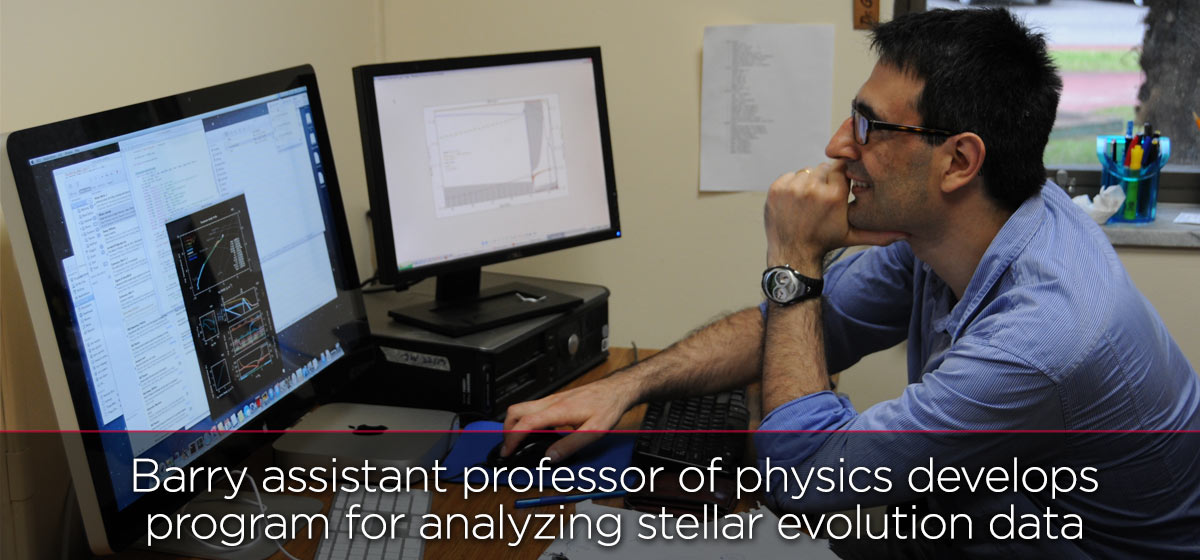Barry University Assistant Professor of Physics Maurizio Giannotti, Ph.D., has developed an interface that provides astrophysicists with a new way of analyzing output data related to stellar evolution. The graphical interface, named MESAFace, was developed along with Michael Wise, a laboratory technician for Barry’s Department of Physical Sciences, and Aaron Mohammed, a rising senior in Barry’ s RISE (Research Initiative for Scientific Enhancement) program.
The program’s name and purpose stems from the code MESA (Modules for Experiments in Stellar Astrophysics), developed by computational scientist Bill Paxton, Ph.D., which has become popular among astrophysicists as a powerful and reliable way to simulate stellar evolution – the changes stars experience during their lifetimes. Analyzing the output data that MESA produces, however, can be challenging and time-consuming for astrophysicists, which inspired Giannotti, Wise and Mohammed to create a solution that would assist them and others in their own research.
“I’m not a programmer; I’m a physicist,” Giannotti said. “We use it [MESAFace] to write our own papers.”
During the summer of 2012, Giannotti, Wise and Mohammed built a customized computer with 24 GB of RAM, an amount of memory that is substantially higher than what a standard computer has. The computer was also built with the latest generation Intel processor and an oversized vent, which prevented the computer from overheating while running for several days at a time. After assembling the computer by hand, Giannotti, Wise and Mohammed spent nearly two months designing the MESAFace software before launching the finished program in early August.
The program, which works with MESA data to create plots representing the stellar evolution of a star, has eliminated the need to spend weeks analyzing the dense data output from MESA.
“Even Bill Paxton is using it now,” Giannotti said.
Since the launch of MESAFace, the software has been downloaded more than 300 times. The software is being downloaded mostly in the United States but is also being downloaded internationally, Giannotti said.
“It’s nice when you know that you’ve somehow influenced a field,” Wise said.
In October, Giannotti, Wise and Mohammed presented MESAFace to the Florida Section of the American Association of Physics Teachers during a conference in St. Petersburg, Fla. In April, the three developers published an article in the international journal Computer Physics Communications titled “MESAFace, a graphical interface to analyze the MESA output,” and in August, Giannotti will visit the University of California, Santa Barbara to meet with Paxton and present a guest lecture on MESAFace at the university’s MESA Summer School – an important step in the development and recognition of MESAFace, as Giannotti is one of few presenters who are not original developers of MESA.
Although the program is popular among graduate students and astrophysicists who use MESAFace in their own research, it is not being used regularly in undergraduate physics classes just yet due to the fact that MESA requires certain resources in order to run, including a compatible operating system.
In the future, however, Giannotti, Wise and Mohammed hope that MESAFace will become accessible not only to undergraduate astrophysics and astronomy classes but also to high school classes.
“I do hope to see MESAFace in classrooms one day, because it makes it possible for students to be exposed to something like MESA, a code that is usually only in the hands of scientists actually working in the field,” Mohammed said. “I believe that it has the potential to inspire students to pursue studying things like astrophysics or computer programming.”
To learn more about MESAFace, visit http://www.mgiannotti.com/mesaface.php

